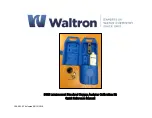
19
WIKA operating instructions, model PGW23.100.11
EN
14391169.01 10/2020 EN/DE
In accordance with the general technical regulations for pressure gauges (e.g. EN 837-2
“Selection and installation recommendations for pressure gauges”).
When screwing the instruments in, the force required for sealing must not be applied
through the case, but only through the spanner flats provided for this purpose, and using
a suitable tool.
For parallel threads, use flat gaskets, lens-type sealing rings or WIKA profile sealings at
the sealing face
. With tapered threads (e.g. NPT threads), sealing is made in the
threads
, using a suitable sealing material (EN 837-2).
The tightening torque depends on the sealing used. In order to orientate the measuring
instrument so that it can be read as well as possible, a connection with LH-RH union or
union nut should be used. When a blow-out device is fitted to an instrument, it must be
protected against being blocked by debris and dirt.
Check the sealing at the process connection over the entire scale range before commissioning.
Safety instructions for installation
■
Install instruments in accordance with the manufacturer's instructions and the valid
standards and regulations.
Installation
■
Nominal position per EN 837-3 / 9.6.6 figure 7: 90° ( ⊥ )
■
Process connection lower mount
■
With filled versions the vent valve at the top of the case must be opened before
commissioning!
■
For outdoor applications, the selected installation location has to be suitable for the
specified ingress protection, so that the instrument is not exposed to impermissible
weather conditions.
■
In order to avoid any additional heating, the instruments must not be exposed to direct
solar irradiation while in operation!
■
To ensure that the pressure can be safely vented in the case of a failure, a minimum
distance of 20 mm from any object must be maintained.
Installation with open-ended
spanner
Sealing in the thread
Spanner flats
Sealing face
6. Commissioning, operation
















































